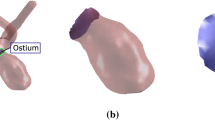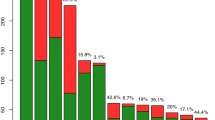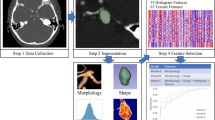Abstract
Intracranial aneurysms are polymorphic focal arterial dilations, which harbor a variable risk of rupture leading to high morbidity and mortality. Increased detection of incidental aneurysms by non-invasive imaging has created a need for rupture risk stratification tools, in addition to simple aneurysm size, to guide optimal treatment strategy. To this end, shape analysis has emerged as a possible differentiator of rupture likelihood. A novel set of morphological parameters based on the writhe number are introduced here to describe aneurysms and discriminate rupture status. Classification in 117 saccular aneurysms (52 ruptured and 65 unruptured) is based on statistical analysis of writhe number distribution on the aneurysm surface. Aneurysms are analyzed both in isolation and including a portion of their parent vessel. Sidewall and bifurcation aneurysm subtypes were found to be best described by disjoint sets of shape parameters, yielding a morphological dichotomy between the two aneurysm classes. Writhe number analysis results in 86.7% accuracy on sidewall (SW) aneurysms and 71.2% accuracy on bifurcation (BF) aneurysms. This represents a 12% accuracy increase for both subtypes compared to the performance of seven established 2D and 3D indexes. The results support the utility of writhe number aneurysm shape analysis, with potential clinical value in rupture risk stratification.







Similar content being viewed by others
References
Beer, F. P., E. R. Johnston Jr., E. R. Eisenberg, and G. H. Staab. Vector Mechanics for Engineers: Statics. Ohio: McGraw-Hill Science, 2003.
Bowman, A. W. and A. Azzalini. Applied Smoothing Techniques for Data Analysis. New York: Oxford University Press, 1997.
Coert, B. A., S. D. Chang, H. M. Do, M. P. Marks, and G. K. Steinberg. Surgical and endovascular management of symptomatic posterior circulation fusiform aneurysms. J. Neurosurg. 106:855–865, 2007.
Dhar, S., M. Tremmel, J. Mocco, M. Kim, J. Yamamoto, A. H. Siddiqui, L. N. Hopkins, and H. Meng. Morphology parameters for intracranial aneurysm rupture risk assessment. Neurosurgery 63(2):185–197, 2008.
Ford, M. D., Y. Hoi, M. Piccinelli, L. Antiga, and D. A. Steinman. An objective approach to digital removal of saccular aneurysms: technique and applications. Br. J. Radiol. 82:55–61, 2009.
Fuller, F. B. The writhing number of a space curve. Proc. Natl. Acad. Sci. USA 68(4):815–819, 1971.
Hardle, W. Applied Nonparametric Regression. Cambridge: Cambridge University Press, 1990.
Harrell, F. E. Regression Modeling Strategies. Springer Series in Statistics, 2001.
Hoh, B. L., C. L. Sistrom, C. S. Firment, G. L. Fautheree, G. J. Velat, J. H. Whiting, J. F. Reavey-Cantwell, and S. B. Lewis. Bottleneck factor and height–width ratio: association with ruptured aneurysms in patients with multiple cerebral aneurysms. Neurosurgery 61(4):716–723, 2007.
Hurdal, M. K., J. B. Gutierrez, C. Laing, and D. A. Smith. Shape analysis for automated sulcal classification and parcellation of MRI data. J. Comb. Optim. 15(3):257–275, 2008.
Lauric, A., E. Miller, S. Frisken, and A. M. Malek. Automated detection of intracranial aneurysms based on parent vessel 3D analysis. Med. Imaging Anal. 14:149–159, 2010.
Ma, B. S., R. E. Harbaugh, and M. L. Raghavan. Three-dimensional geometrical characterization of cerebral aneurysms. Ann. Biomed. Eng. 32(2)264–273, 2004.
Millan, R. D., L. Dempere-Marco, J. M. Pozo, J. R. Cebral, and A. F. Frangi. Morphological characterization of intracranial aneurysms using 3-d moment invariants. IEEE Trans. Med. Imaging 26(9):1270–1282, 2007.
Millington, I. Game Physics Engine Development. Menlo Park: Morgan Kaufmann, 2007.
Pham, D. L., C. Xu, and J. L. Prince. Current methods in medical image segmentation. Annu. Rev. Biomed. Eng. 2:315–337, 2000
Raghavan, M. L., B. Ma, and R. E. Harbaugh. Quantified aneurysm shape and rupture risk. J. Neurosurg. 102(2):355–362, 2005.
Rohde, S., K. Lahmann, J. Beck, R. Nafe, B. Yan, A. Raabe, and J. Berkefeld. Fourier analysis of intracranial aneurysms: towards an objective and quantitative evaluation of the shape of aneurysms. Neuroradiology 47(2):121–126, 2005.
Rossetto, V. and A. C. Maggs. Writhing geometry of open DNA. J. Chem. Phys.118:9864–9874, 2003
Sethian, J. A. Level Set Methods and Fast Marching Methods. Cambridge: Cambridge University Press, 1999.
Ujiie, H., H. Tachibana, O. Hiramatsu, A. L. Hazel, T. Matsumoto, Y. Ogasawara, H. Nakajima, T. Hori, K. Takakura, and F. Kajiya. Effects of size and shape (aspect ratio) on the hemodynamics of saccular aneurysms: a possible index for surgical treatment of intracranial aneurysms. Neurosurgery 45(1):119–130, 1999.
Wardlaw, J. M. and P. M. White. The detection and management of unruptured intracranial aneurysms. Brain 123(2):205–221, 2000.
Wiebers, D. O. Unruptured intracranial aneurysms: natural history, clinical outcome, and risks of surgical and endovascular treatment. Lancet 362(9378):103–110, 2003.
Wiebers, D. O. Patients with small, asymptomatic, unruptured intracranial aneurysms and no history of subarachnoid hemorrhage should generally be treated conservatively: for. Stroke 36:408–409, 2005.
Wolfe, S. Q., M. K. Baskaya, R. C. Heros, and R. P. Tummala. Cerebral aneurysms: learning from the past and looking toward the future. Clin. Neurosurg. 53:157–178, 2006.
Author information
Authors and Affiliations
Corresponding author
Additional information
Associate Editor Joan Greve oversaw the review of this article.
Electronic supplementary material
Below is the link to the electronic supplementary material.
Rights and permissions
About this article
Cite this article
Lauric, A., Miller, E.L., Baharoglu, M.I. et al. 3D Shape Analysis of Intracranial Aneurysms Using the Writhe Number as a Discriminant for Rupture. Ann Biomed Eng 39, 1457–1469 (2011). https://doi.org/10.1007/s10439-010-0241-x
Received:
Accepted:
Published:
Issue Date:
DOI: https://doi.org/10.1007/s10439-010-0241-x




